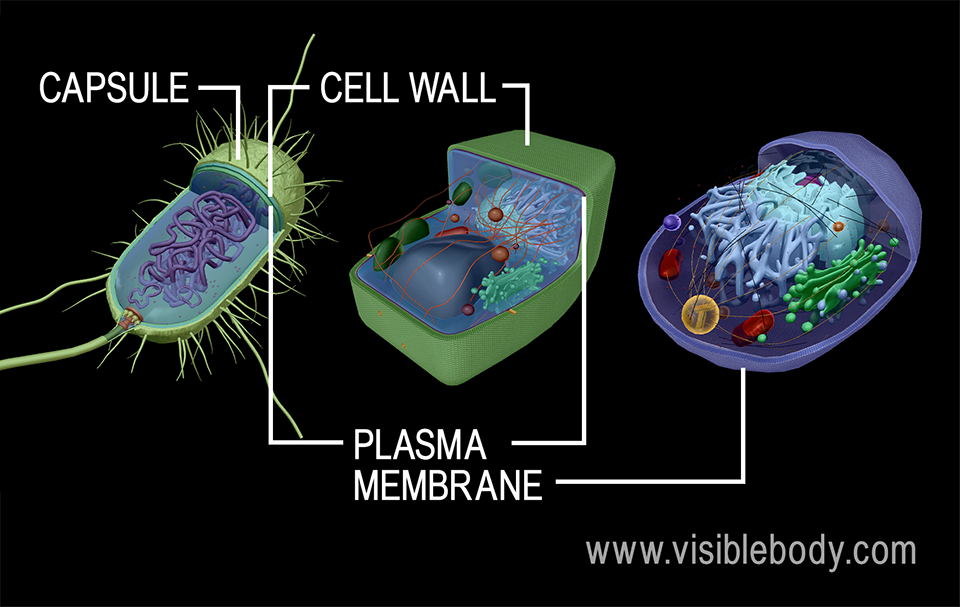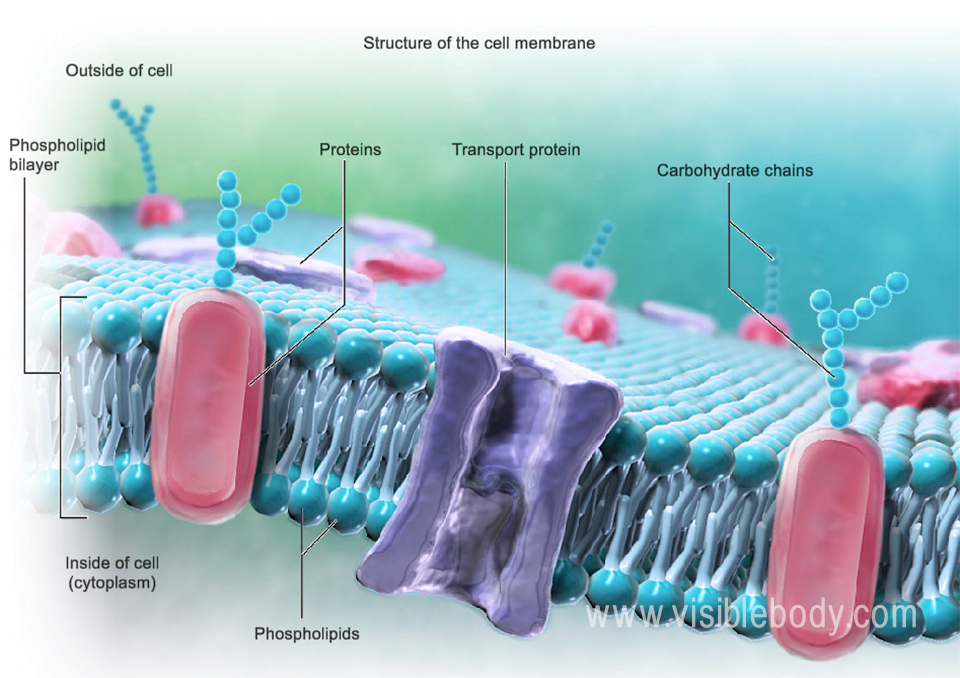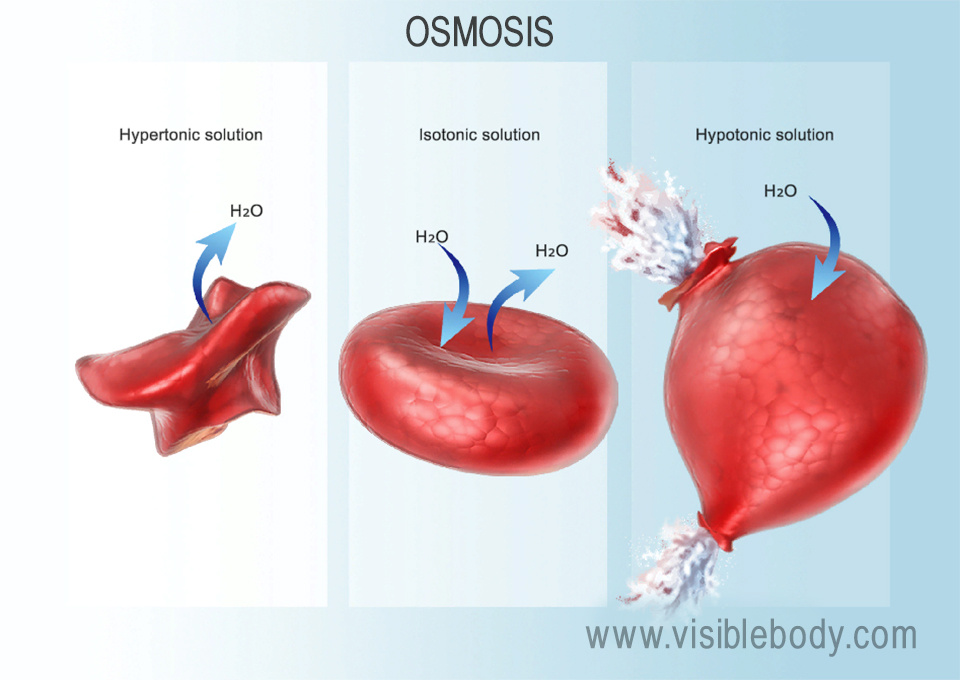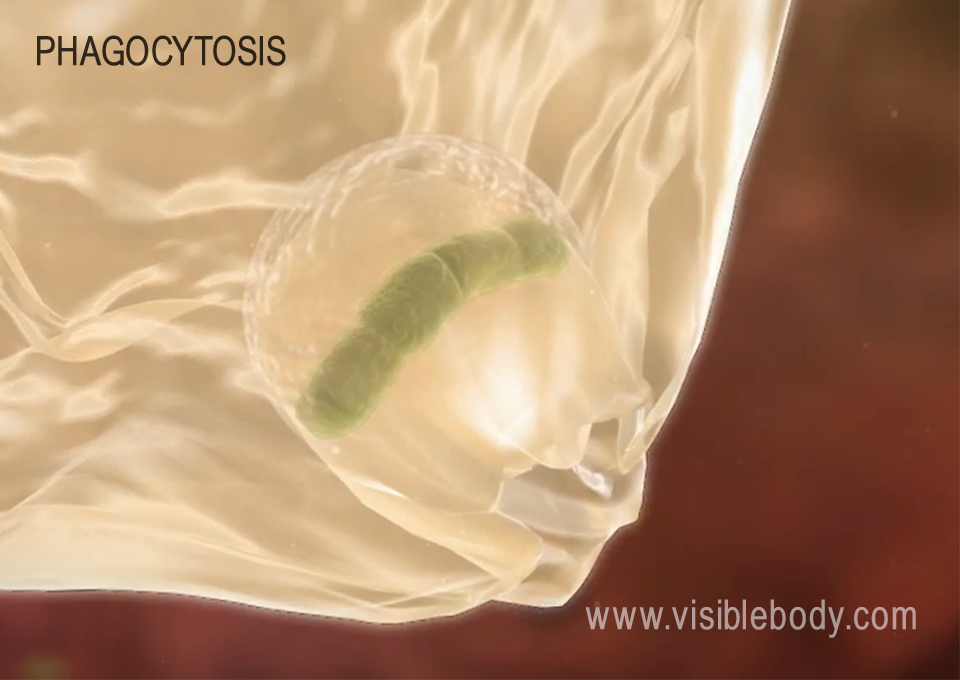There are two general categories of cells: prokaryotic and eukaryotic. Sometimes, organisms are referred to as prokaryotes or eukaryotes, based on the type of cell(s) that compose them.
Animal, plant, and bacterial cells are surrounded by a plasma membrane, which separates the cell’s internal environment from the external environment. The plasma membrane protects the contents of the cell and regulates which molecules can enter and leave it. It is “selectively permeable,” which means that some substances can freely cross it, while others are kept out and require the cell to use energy to power transport.
Plant and bacterial cells have additional layers of protection in the form of a cell wall (for both plant and bacterial cells) and a capsule (for bacterial cells).

In all types of cells, the plasma membrane is a lipid bilayer. This means it is composed of two layers of phospholipid molecules, which each have a polar, phosphate-containing “head” and two nonpolar, fatty acid “tails.” The heads are hydrophilic, or attracted to water. They face outward toward the exterior of the cell as well as the cytosol on the inside of the cell. The tails are hydrophobic, or repelled by water, and face inward toward each other.

Cholesterol in the plasma membrane is important for maintaining the membrane’s fluidity.
Various proteins in and around the lipid bilayer serve a number of functions, including acting as markers and receptors and forming channels to help substances cross the membrane.
The plasma membrane also contains carbohydrates, which are attached to proteins or lipids. These form part of the sites on the outside of the cell that allow it to be recognized by and interact with other cells.
Some substances – gases, nutrients, and waste – can move in and out of cells without the cell needing to expend any energy. This is called passive transport.
Diffusion is a common example of passive transport. It happens when the concentration of certain molecules on one side of the cell membrane is higher than the concentration on the other side. These molecules will move across the cell membrane from the area of higher concentration to the area of lower concentration — that is, they will move down the concentration gradient — until equilibrium is reached.
Typically, molecules that undergo passive transport are small and nonpolar, like oxygen (O2) and carbon dioxide (CO2). Fat soluble substances, such as steroids and vitamins A, D, E, and K, can also cross the membrane without the need to expend energy because it is easy for them to pass through the hydrophobic center of the lipid bilayer. In contrast, most polar molecules, ions, simple sugars, and amino acids can’t cross the plasma membrane on their own. As you’ll see in the next section, water is polar but doesn’t require energy to cross the cell membrane.
Sometimes, transport proteins can help molecules (like water) cross the membrane without expending energy by serving as channels or carriers. This is called facilitated transport or facilitated diffusion.
Even though water molecules are polar, they are small enough that they don’t require active transport to cross the plasma membrane—channels called aquaporins allow water to cross the cell membrane. In fact, there is a special term for the passive diffusion of water across cell membranes: osmosis.
The direction water molecules will move in depends on the concentration of the solution inside and outside the cell. In an isotonic solution, animal cells function normally because the intake and output of water is balanced. If a cell is not in an isotonic solution — that is, if the balance of water inside and outside the cell is thrown off — damage to the cell can occur. For example, in a hypertonic solution, there is a greater concentration of water inside the cell than outside it. Water therefore diffuses out of the cell, and it shrinks. In a hypotonic solution, there is a greater concentration of water outside the cell than inside it. Water floods into the cell, making it swell and potentially burst.

In contrast, plant cells won’t burst when placed in a hypotonic solution—their large central vacuoles take in water, which exerts turgor pressure on the cell wall. A plant cell in which the central vacuole is full and cytoplasm and plasma membrane are pushing right up against the cell wall is referred to as turgid. When in a hypertonic solution, water will leave the central vacuole and the cell wall will sag due to lack of support. This is what causes plants to appear wilted when they haven’t been watered in a while.
Active transport happens when cells need to move molecules against their concentration gradient, or they need to move ions or large or polar molecules across the cell membrane. The cell uses energy (ATP) in combination with specialized channel or carrier proteins to move molecules in or out of the cell.
Because active transport often involves ions — molecules with a positive or negative charge — we’ll need to talk about electrochemical gradients. The inside of cells is negatively charged compared to the extracellular fluid around them. The interior of cells also has a higher concentration of potassium (K+) and lower concentration of sodium (Na+) than the extracellular fluid. The electrochemical gradient for an ion is a combination of the concentration gradient and the differences in charge on either side of the cell membrane.
There are two main types of active transport: primary and secondary. Primary active transport uses ATP to move a substance across the cell membrane against their concentration gradient. For example, a sodium potassium pump, like the ones found in neurons and muscle cells, moves 2 potassium ions into the cell and moves 3 sodium ions out. This changes the electrical charge and concentration on either side of the membrane.

Secondary active transport, or cotransport, can use this electrochemical gradient to move molecules across the membrane. Amino acids and glucose can be moved into the cell using secondary active transport.
For moving really large particles — including entire other cells — across the cell membrane, the cell uses endocytosis. This is sometimes referred to as bulk transport. In endocytosis, part of the cell membrane invaginates to create a pocket around the material being brought into the cell. This pocket then pinches off of the membrane to form a vacuole inside the cell. Phagocytosis is an example of endocytosis found in macrophages in the human immune system—these cells consume and destroy pathogens.

Exocytosis is essentially the reverse of this process. A vesicle containing the material to be moved across the cell membrane fuses with the membrane and then that portion of the membrane opens up, releasing its contents. The release of neurotransmitters at a synapse is an example of exocytosis in the human nervous system.
An article on polar and non-polar molecules from Northern Arizona University.
BBC Bitesize: Transport Across Membranes
NCBI Bookshelf article: The Cell Membrane
OpenStax Concepts of Biology Chapter 3: Cell Structure and Function
Wu et al. (2013): Exocytosis and Endocytosis: Modes, Functions, and Coupling Mechanisms.
When you select "Subscribe" you will start receiving our email newsletter. Use the links at the bottom of any email to manage the type of emails you receive or to unsubscribe. See our privacy policy for additional details.